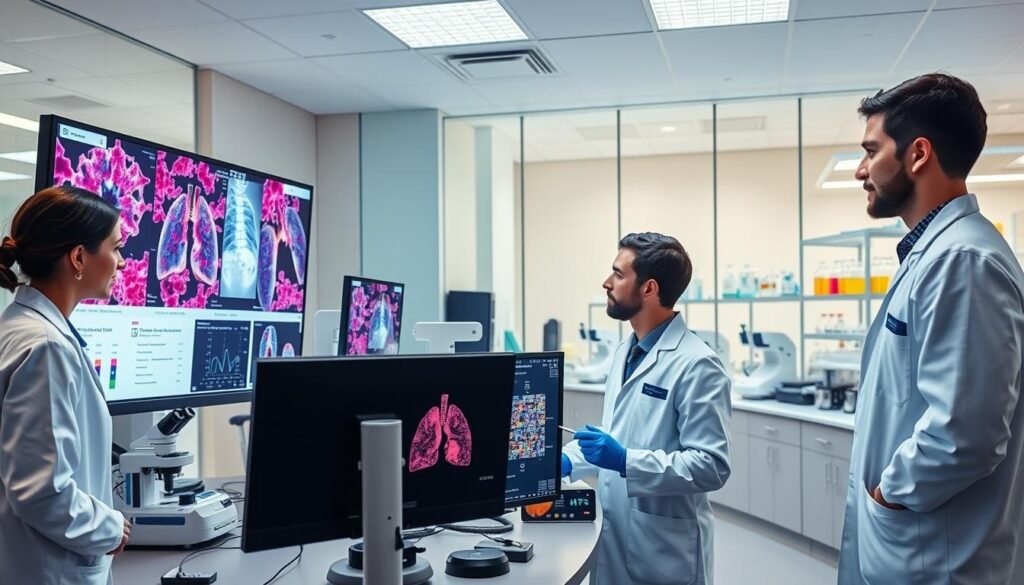Did you know patients treated with Libtayo (cemiplimab) for non-small cell lung cancer (NSCLC) saw progress? They experienced a median survival without the disease worsening for 8.2 months. This compares favorably to the 5.7 months with traditional chemotherapy. Immunotherapy is becoming key in achieving better outcomes for patients. This lung cancer treatment guide 2024 looks closely at Libtayo. It covers its workings, how well it performs, and how it fits into broader treatment plans for NSCLC.
The fight against lung cancer is evolving, thanks to new treatments like Libtayo. It’s at the forefront of immunotherapy. Learning about how Libtayo works, the right dosing schedule, and possible side effects is key. Patients, those who care for them, and doctors will find the next parts of this guide useful. It outlines the important aspects of this promising therapy.
Key Takeaways
- Libtayo significantly improves progression-free survival compared to conventional chemotherapy.
- It is an essential immunotherapy option for advanced or metastatic NSCLC.
- Libtayo dosing occurs every three weeks and can continue for up to 24 months.
- Combining Libtayo with chemotherapy shows promising results in clinical trials.
- Understanding side effects is vital for effective treatment management.
- Recent research is paving the way for future advancements in Libtayo’s application.
Introduction to Libtayo and Lung Cancer Treatment
Lung cancer is the second-most common cancer in men and women in the U.S. It starts in the lungs as non-small cell lung cancer (NSCLC). New therapies like Libtayo are changing the way we fight cancer. This treatment harnesses the body’s immune system to attack cancer cells.
Libtayo has become crucial for adults with NSCLC. It’s used on its own for some lung cancers or with chemo for others. Its success depends on a patient’s tumor score. A score of 50% is needed for Libtayo to work by itself.
CT scans play a big role in diagnosing NSCLC early. They help spot small tumors. After finding cancer, doctors figure out its stage. This shows how big the cancer is and if it’s spread. A lower stage means the cancer isn’t very advanced. This information helps doctors choose the best treatment.
Understanding Non-Small Cell Lung Cancer (NSCLC)
Non-small cell lung cancer (NSCLC) is the main type of lung cancer. It makes up about 85% of all cases in the United States. This cancer has several types, like adenocarcinoma and squamous cell carcinoma. Each type affects treatment and recovery differently.
Knowing the stage of NSCLC is key in picking the right treatment. The cancer is put into one of five stages. This helps doctors plan the best approach.
| NSCLC Stage | Characteristics |
|---|---|
| Stage 0 | Cancer is confined to the lining of the airways, with no spread. |
| Stage 1 | Cancer remains small, not extending beyond the lungs or into lymph nodes. |
| Stage 2 | Cancer may be larger than in stage 1 and may have invaded local lymph nodes. |
| Stage 3 | Cancer has spread to more distant lymph nodes within the chest, termed locally advanced. |
| Stage 4 | Cancer is metastatic, having spread to other organs beyond the lungs. |
Understanding NSCLC types and stages is vital. It helps raise awareness and guides treatment. Tumor size, location, and patient health impact treatment choices. With new research and treatments, knowing these details helps fight lung cancer.
Libtayo Lung Cancer: How It Works
Libtayo is making waves as a promising treatment for advanced non-small cell lung cancer (NSCLC). It boosts the body’s immune system to find and kill cancer cells. Learning about its immunotherapy methods shows how it helps patients fight this tough disease.
The Mechanism of Immunotherapy
Immunotherapy is changing how we treat cancer. It works by making the body’s immune system attack cancer cells. Libtayo, which contains cemiplimab, stops a protein called PD-1. This prevents tumors from hiding from the immune system. This approach improves the chances for people with advanced NSCLC.
Libtayo’s Role in Targeting PD-1
PD-1 is a protein that helps control the immune response. Cancer uses it to avoid being found by the immune system. Libtayo targets PD-1, offering a new way to fight cancer. Trials show patients on Libtayo live longer than those on chemotherapy. Specifically, 70% of Libtayo patients were alive at 22.1 months, versus 60% for chemotherapy.
| Clinical Trials Overview | Libtayo (Cemiplimab) | Chemotherapy |
|---|---|---|
| Median Overall Survival | 22.1 months | 14.3 months |
| Risk of Cancer Progression | Reduced by 41% | N/A |
| Patients Alive Without Disease Progression at 6.2 Months | 50% | 5.6 months |
| Patients Alive at 6 Months | 70% | 60% |
Considering Libtayo? Know how it works and its proven benefits for survival. Libtayo changes how we treat cancer, giving hope to those with advanced NSCLC. For more info about Libtayo, click here.
Current Treatment Options for NSCLC
Non-small cell lung cancer (NSCLC) has various treatment options. They are chosen based on the cancer stage and the patient’s health. Treatments range from surgery to advanced options like chemotherapy and radiation.
Surgical Interventions
Surgery is crucial, especially for early-stage NSCLC. Stage 0 often requires only surgery, avoiding chemotherapy or radiation. As the disease advances, more complex surgeries might be needed. For stage I NSCLC, adding treatments like chemotherapy after surgery can lower the risk of the cancer coming back.
Radiation and Chemotherapy
Chemotherapy and radiation are key for many NSCLC cases. Stage II often starts with neoadjuvant chemotherapy to shrink the tumor. In later stages, like IIIB, combining chemotherapy with radiation improves treatment success. This makes these treatments vital parts of care.
Immunotherapy Developments
New immunotherapy methods have changed NSCLC treatment. Using specific markers, drugs like pembrolizumab work alongside chemotherapy. Combining surgery with these drugs may improve survival for advanced NSCLC patients. These advances show a move towards more personalized treatment.

| Treatment Stage | Surgery | Chemotherapy | Radiation Therapy | Immunotherapy |
|---|---|---|---|---|
| Stage 0 | Often curative | No | No | No |
| Stage I | Adjuvant possible | Post-surgery | No | Considered |
| Stage II | Possible | Neoadjuvant | No | Considered |
| Stage IIIA | Possible | Adjuvant | Post-surgery | Considered |
| Stage IIIB | No | Often combined | Commonly used | Considered |
| Stage IV | Sometimes | Often used | Used for symptom relief | Key option |
Choosing Libtayo for NSCLC Treatment
Choosing Libtayo is a big step in treating NSCLC. Doctors and patients look at many factors related to their lung cancer. This includes looking at PD-L1 expression levels in the tumor. For advanced NSCLC, Libtayo is often the first choice. It’s used when PD-L1 is found in 50% or more of the tumor cells. This info helps decide the best treatment path.
Libtayo’s success is shown through research. In the EMPOWER-Lung 1 trial, patients taking Libtayo had 8.2 months without disease worsening. This is better than the 5.7 months seen with chemotherapy. These findings show Libtayo’s value in treatment plans.
Another study, the EMPOWER-Lung 3, focused on combining Libtayo with chemo. Here, the mix gave patients 21.9 months of survival, against 13 months with placebo and chemo. This underscores looking at combo therapies when planning NSCLC treatment.
For those on Libtayo, regular check-ups are key. The treatment is given every three weeks for two years, but plans may change based on how well a patient responds. It’s critical to weigh the pros and cons of treatments. Making an informed choice helps meet long-term health goals.
Combining Libtayo with Other Treatments
Adding Libtayo to the treatment plan for lung cancer marks a big step forward in care. It is combined with chemotherapy to improve how well patients do. This approach has shown promising results in clinical studies.
Use of Libtayo with Chemotherapy
On November 8, 2022, the FDA gave the thumbs up for using Libtayo with certain chemotherapies for advanced lung cancer. Study 16113 featured 466 adults in its research. Participants were given either Libtayo and chemotherapy or a placebo with chemotherapy.
The outcomes revealed a notable increase in survival rates. People taking Libtayo lived about 21.9 months compared to 13.0 months for those on the placebo. This shows the potential of Libtayo with chemo to help patients live longer.
Clinical Trials and Combination Therapies
Clinical trials for immunotherapy, like the one mentioned, highlight Libtayo’s potential when used with chemotherapy. In the study, 43% of those treated with Libtayo responded positively, versus 23% with the placebo. These findings show the promise of Libtayo in combination therapies.
Ongoing research is crucial for advancing treatment options. With continued trials, there’s hope for better outcomes and quality of life for lung cancer patients.

Side Effects and Managing Libtayo Treatment
Libtayo is used to treat lung cancer but may cause side effects. It’s important to know these effects for better care. Knowing them helps patients and doctors manage the treatment better, making the process smoother.
Common Side Effects of Libtayo
The treatment often leads to mild side effects such as:
- Nausea
- Fatigue
- Skin rash
- Diarrhea
- Decreased appetite
- Constipation
- Joint pain
- Urinary tract infections
Though rare, some may experience serious side effects like:
- Immune-mediated reactions
- Reduced blood cell levels
- Pneumonia and other serious infections
- High blood pressure
- Electrolyte imbalances
- Symptoms like mood changes or breathing issues
Strategies to Manage Side Effects
Managing side effects is a team effort between patients and doctors. Some key ways include:
- Open Communication: Talk about any side effects to adjust treatments if necessary.
- Symptom Tracking: Note down symptoms for quick action on severe side effects.
- Supportive Medications: Medicines for nausea or pain can make treatment more comfortable.
- Healthy Lifestyle Choices: A balanced diet and enough water may lessen mild side effects.
- Physical Activity: Light exercise can help reduce fatigue and boost well-being.
| Type of Side Effect | Common Examples | Management Strategies |
|---|---|---|
| Mild | Nausea, Fatigue, Skin Rash | Symptom tracking, supportive medications |
| Serious | Immune Reactions, Infections | Open communication, prompt medical attention |
| Long-term | Bone Pain, Increased Liver Enzymes | Regular check-ups, lifestyle modifications |
Latest Research and Clinical Trials for Libtayo
The treatment landscape for lung cancer is changing fast, thanks to immunotherapy. Libtayo is a promising new treatment for non-small cell lung cancer (NSCLC). Various clinical trials have shown impressive results. The recent studies on Libtayo have shown it’s particularly effective for patients with high PD-L1 expression. In fact, Libtayo lowered the risk of death by 32% compared to chemotherapy in patients with PD-L1 levels of 50% or more.
Key Clinical Trial Findings
The data show patients taking Libtayo had a median overall survival of 22 months. This compares to just 14 months for those on chemotherapy. The median time before the cancer worsened was also better with Libtayo, at 6.2 months, compared to 5.6 months with chemotherapy. These results, including a stunning 43% lower risk of death for certain patients, will greatly impact cancer research and care
Future Directions in Libtayo Research
Researchers are now looking at using Libtayo for other cancers, not just NSCLC. They’re trying to find the best way to combine it with other treatments to help more patients. Given the success we’ve seen, it’s vital to keep researching to make cancer care better. Staying updated with the latest data on immunotherapy like Libtayo is key in the fight against cancer.

| Metric | Libtayo | Chemotherapy |
|---|---|---|
| Median Overall Survival | 22 months | 14 months |
| Median Progression-Free Survival | 6.2 months | 5.6 months |
| Risk of Death Reduction (≥50% PD-L1) | 32% | N/A |
| Risk of Death Reduction (subset ≥50% PD-L1) | 43% | N/A |
Making Decisions About Libtayo Treatment
When it comes to cancer care, choosing Libtayo treatment is a big decision. Patients have many options, and it’s key to think about their own situation. They get to work closely with their doctors and care teams, making decisions together.
Deciding on cancer treatment isn’t simple. It means looking at many factors like what you hope to achieve, your personal choices, and how well treatments work. Libtayo has been effective for certain lung cancer patients, specifically those with a high PD-L1 expression.
Thinking about Libtayo treatment? Here are some things to consider:
- Understanding Treatment Efficacy: Libtayo lowered the risk of dying by 43% compared to chemotherapy for some patients. Those treated with Libtayo lived a median of 22 months, which shows its potential benefits.
- Evaluating Risks and Side Effects: Side effects like rash and cough can impact your decision. It’s important to balance these against Libtayo’s benefits.
- Cost Considerations: Expect to pay about $10,933 for a 28-day cycle of Libtayo. Knowing the costs is crucial for making a well-informed decision.
- Coordination with Healthcare Team: Talking with your doctors and specialists helps create a treatment plan that suits you best, based on your needs and wants.
Staying informed and involved in your cancer treatment choices is more important than ever. As cancer care improves, patients who actively participate in their treatment planning navigate their journey better.
| Factor | Details |
|---|---|
| Treatment Efficacy | 43% reduction in death risk; median overall survival of 22 months. |
| Common Side Effects | Rash, cough, immune-mediated conditions. |
| Cost | Approximately $10,933 per 28 days for treatment. |
| Collaboration | Value of working with healthcare professionals to assess personal needs. |
Conclusion
Libtayo is a big leap forward in fighting non-small cell lung cancer (NSCLC), especially for those at advanced stages. The EMPOWER-Lung 3 trial showed it improves lung cancer treatment outcomes. This is when used with platinum-doublet chemotherapy.
The trial found a median overall survival of 21.9 months with Libtayo, versus 13.0 months for placebo. This shows Libtayo’s potential to help patients live longer.
Advances in cancer care look promising, but we should tailor treatments to each person. The trial data show that results can vary among different groups. It’s important to talk with doctors about Libtayo’s benefits and side effects. This way, treatments can be customized to get the most benefit.
In short, Libtayo brings hope to those fighting lung cancer. It also highlights the need for ongoing research and discussion in cancer care. With new therapies on the horizon, their thoughtful use is key to better outcomes.